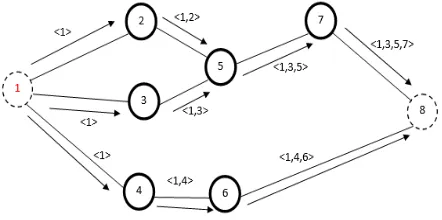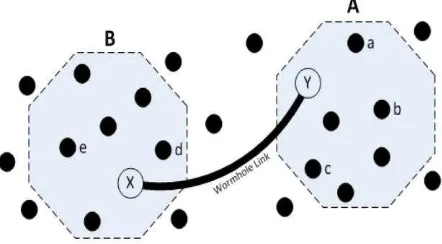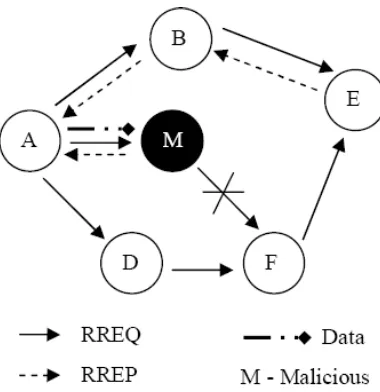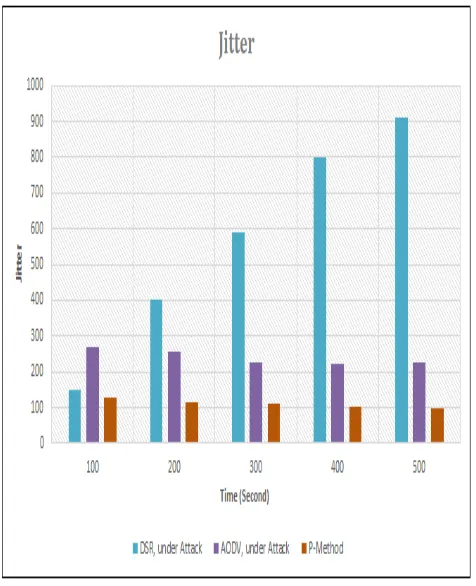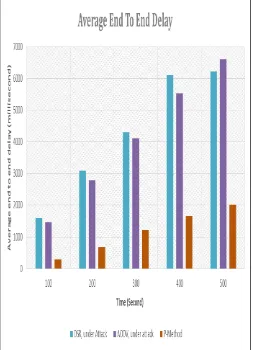Vol. 14, No. 6, June 2016
P-Method: Improving AODV Routing Protocol for
Against Network Layer Attacks in Mobile Ad-Hoc
Networks
Shahram zandiyan and Reza fotohi
Department of Computer Engineering Germi branch, Islamic Azad universityGermi, Iran
Marzieh koravand
Department of Computer Engineering Germi branch, Islamic Azad university
Germi, Iran
Abstract—Mobile ad hoc networks are regarded as a group of networks consisted of wireless systems which developing together a network with self-arrangement capability. no constant communication infrastructure and use central nodes to communicate with other nodes. Despite lots of advantages, these networks face severe security challenges, since their channels are wireless and each node is connected to central node. One of these concerns is the incidence of network layer attacks (Black and worm hole attack) is one kind of routing disturbing attacks and can bring great damage to the network. In this attack, an attacker cheats nodes, absorbs their packets and then deletes them. Hence, black hole and wormhole disrupts communication, or even makes it impossible in some cases. In this paper, we proposed P-Method for against network layer attacks in mobile Ad-Hoc networks based on hop count and RTT test. The proposed algorithm is implemented in ns2.35 environments and is compared with AODV And DSR under attacks, and improved AODV in different scenarios. Simulation results revealed that the (P-method), is better than AODV And DSR under attack in terms of packet dropped, packet loss, throughput, and jitter.
Keywords- Mobile ad hoc networks, AODV and DSR routing protocol, Black hole attack, Worm hole, P-Method.
I. INTRODUCTION
Mobile Ad-hoc network is one kind of new wireless network structures. Unlike devices in traditional Wireless LAN solutions, all nodes are movable and the topology of the network is changing dynamically. Similar to other systems, there is a risk of external agent infiltration in the mobile ad hoc networks. In these networks there is basically no infrastructure, that is no routing devices such as router or switch is used. So, they are highly posed to the risk of various.one the most common attacks in MANET is Black hole attack and worm hole; black hole and worm hole attack, a
Vol. 14, No. 6, June 2016 be based on hop count and RTT We implement the proposed
scheme over AODV routing protocol in ns-2 2.35 environment. Organized as follows. Section 2 Related work. Section 3 describes the AODV routing protocol. In section 4 networks are dynamic, infrastructure less and scalable. Despite the fact of popularity of MANET, these networks are very much exposed to attacks [6]. Wireless links also makes the MANET more susceptible to attacks which make it easier for the attacker to go inside the network and get access to the ongoing communication [7]. Different kinds of attacks have been analyzed in MANET and their effect on the network. Attack such as gray hole, worm hole, black hole, where the attacker node behaves maliciously for the time until the packets are dropped and then switch to their normal behavior [8]. MANETs routing protocols are also being exploited by the attackers in the form of flooding attack, which is done by the attacker either by using RREQ or data flooding [9]. Design and presentation of different security obstacles and attacks in mobile ad hoc networks as well as finding appropriate solutions against them is a challenging research area for researchers. Black hole attack is one of the famous related attacks. In [10], black hole attack is evaluated in DSR based networks and a solution is proposed to mitigate it, as well. In such papers, fake routes are only suggested in response to RREQ packets. In [11], and [12] Black hole attack is assessed in DSR based networks and in [13], is considered in AODV to separate. This malicious node advertises its availability of fresh routes irrespective of checking its routing table. In this way attacker node will always have the availability in replying to the route request and thus intercept the data packet and retain it [15, 16]. Using AODV [17] protocol. But they do not consider the data packets. Instead they consider only control packets like RREQ, RRER and RREP and network layer acknowledgement. A black hole can even drop data packets by perfectly transmitting control packets. There the system fails by thinking there is no black hole as the control packets are transmitted without any delay or drop. Many approaches to detect the black hole attack and to defend The MANET from the attack have been proposed [18]-[19]. According to the algorithm by Deng et al. [20], every node crosses check with
Vol. 14, No. 6, June 2016 last sent packet from the destination to the source. If the
destination sequence number present in the routing table is lesser than or equal to the one contained in the RREQ packet, then the node relays the request further to its neighbors. If the number in the routing table is higher than the number in the packet, it denotes that the route is a ‘fresh route’ and packets can be sent through this route. This intermediate node then sends a RREP packet to the node through which it received the RREQ packet. The RREP packet gets relayed back to the source through the reverse route. The source node then updates its routing table and sends its packet through this route. During the operation, if any node identifies a link failure it sends a RERR (Route Error) packet to all other nodes that uses this link for their communication to other nodes. This is illustrated in figure 1 and 2.
Fig. 1.Broadcast to AODV route discovery
Fig. 2.A sample of route discovery in AODV protocol
IV.DESCRIBESTHEDSRROUTING
DSR protocol is a reactive routing algorithm designed for mobile adhoc network. The process of routing in DSR is composed of two main phases known as route discovery and route maintenance. Routing in DSR is completely carried out in an on-demand method. Route discovery phase is a process under which source node, in order to send data packets, obtains a valid route to the destination node. For this, source node creates a RREQ packet and relays it in the network. Such a packet will be received by all of the sources neighbor nodes. Each RREQ packet contains an identifier and a list of addresses of intermediate nodes which this packet has passed
from them. Such a list is initially empty at the time of creating RREQ by the source node. When a node receives a RREQ packet, creates a RREP regarding information included in the list of addresses inside the packet and sends it back to the source node if only it be the destination node itself or have had a route to the destination. Once source node receives such a RREP packet, it first adds this route to its route cache and then starts to send data packets using the route included in the packet. If the receiver of RREQ has not had a route the destination and has not previously received this RREQ packet, appends its address to the list of nodes inside the packet and rebroadcasts that. When the destination node receives a RREQ, it can create and send back the RREP to the source node using the route which can be computed by inversing the list of addresses inside the RREQ packet. Route maintenance is a mechanism by which, as source node is using a route to send its data packets, can discover changes of topology and send remainder of its packets through an alternative route if it be convinced that the current route has been broken and not usable anymore.
Fig. 3. depicts a discovery route in DSR protocol. (All-over distribution)
Vol. 14, No. 6, June 2016 V. TWOTYPESOFATTACKINMOBILEADHOCE
NETWORK
Attacks in MANET can be divided into two classes, according to the Criteria that whether the disrupt the operation of a routing protocol or not. These two classes are passive attacks and active attacks. In a inactive attack, the operation of the routing protocol is not disrupted by the attacker, and only attempts to discover valuable information by listening to the routing traffic is being done. Active attacks, however, involve actions like modification and deletion of exchanging data to absorb packets destined to other nodes to the attacker for analyzing or disabling the network. Some typical kinds of active attacks can be easily performed against MANET, regarded as, flooding attack, selfing attack, gray hole attack, rushing attck, spoofing, wormhole attack, sleep deprivation and impersonation (Jathe et al, 2012) As mentioned, weak infrastructure in mobile ad-hoc networks exposed them to a large amount of attacks. One of these attacks is the black hole attack (Dokure et al, 2006) Black Hole in the (network layer attacks): all packets dropped by a Forged routing packets, the attacker can route all packets for some destination themselves and then discard them
A. Worm hole attack
Wormhole attack which is considered as a severe attack in mobile ad hoc network. Minimum two malicious nodes are required to perform this attack; more than two malicious nodes are also used to perform this attack. In this attack the two malicious nodes reside in the two ends of the network and they form a link between them using an out-of-band hidden channel like wired link, packet encapsulation or high power radio transmission range [26]. After they form a tunnel between them as shown in figure 1, whenever a malicious node receives packets it tunnels them to the other malicious node and in turn it broadcasts the packet there. Since the packet is travelling through the tunnel it reaches the destination speeder than other route and moreover the hop count through this path is going to be less so this path is established between the source and the destination [27]. Once the path is established between the source and the destination through wormhole link they can misbehave in many ways in the network like continuously dropping the packets, selective dropping the packets, analyzing the traffic and performing Denial of Service attack. Figure 5 shows an example of this attack.
Fig. 5. wormhole attacks In AODV
B. Black hole attack
Vol. 14, No. 6, June 2016
Fig. 6. Black hole attack in AODV
VI.PROPOSEDMETHOD
In this Paper we represent a new against Black hole and Wormhole Attack in Mobile Ad-Hoc Networks based On Hop Count and RTT way called the protection of navigational protocol in occasional portable networks against black holes, and worm holes which is consisted of, hop count & RTT. The proposed method not only specifies forged ways but also it adopts prevention criteria against reborn of destructive attacks in the process of route detection phase.
A. Second Phase: prevention of black holes, wormholes incidence, between the inception and destination with the usage hop count
In ad-hoc On-demand distance vector (AODV) that is a routing protocol in which each node maintains a routing table, one entry per destination, which records the next hop to the destination and its hop count. AODV also uses a sequence number to ensure freshness of routes. AODV discovers a route through network-wide broadcasting. The RREQ ID field is incremented by one from the last RREQ ID used by the current node. Each node maintains only one RREQID. The Hop Count field is set to zero. When a node receives a RREQ, it first creates or updates a route to the previous hop without a valid sequence number then checks to determine whether it has received a RREQ with the same Originator IP Address and RREQ ID within at least the last If such a RREQ has been received, the node silently discards the newly received RREQ. The rest of this subsection describes actions taken for RREQs that are not discarded. In this proposed method, all existing route to the destination node if the node is examined and the number of hop count have fewer And in the way the company is well-known and have lower energy side of the path, and we do not use this route consider as Malicious path of the cycle cast aside as Next, open the node that has less battery power and the number of hop count have low hop count, but the most
responsive to a source node sends this node as malicious node is considered and the cycle of operations being cast aside and The information in this node to all neighboring nodes are distributed. And hop count number to zero, and the path we choose will have more battery power and is submitted in response to any request path number is a good step.
B. The secondly phase: calculating the distance between the inception and destination with RTT
This mechanism which is based on the time and table is used for specifying attacks concerning black holes, silver holes and worm holes, regarding in navigational protocol in the occasional networks, destructive loop always respond to rout reply as quickly as possible and because of this fact that operative loops or the inception doesn’t have any valid information about its distance from the destination, they are deceived rapidly by response of these loops, so for preventing from happening this, we must calculate the total round-trip time for all ways available, between the inception and the destination loop until the actual distance between the inception and destination loop is determined and we can make an accurate decision for transmitting information.
1) Calculating round-trip time or RTT:
Round-trip time; middle interval; can be calculated when the inception loop retransmitted “HELLO” message and the moment the response message for “Hello” is received, meaning it has been informed of the neighbor’s existence. Each individual loop reserves mono-step round-trip time between itself and its neighbors. Aggressor detection mechanism:
A typical loop which have a data for transmitting, should at first detect necessary route toward the destination and after that start transmitting data using that route. This method is exclusively used in specifying safe route.
2) Aggressor detection mechanism:
A typical loop which have a data for transmitting, should at first detect necessary route toward the destination and after that start transmitting data using that route. This method is exclusively used in specifying safe route.
In order to do this, the data transmitting loop perform the following mathematics:
For each available or detected route, its RTT is calculated from the inception to destination.
Then the total amounts RTT for all discovered routes is calculated.
Calculating the RTT’s average for all discovered routes using the previously mentioned amounts.
Vol. 14, No. 6, June 2016
average RTT amount and utilizing that safe route, we send data toward the destination. According to equation (1)
Sending time = value of receive timestamp -
value of original timestamp (1)
Equation (1) specifies transmitting time course which in fact is a timestamp, representing the differentiation between receiving timestamp with transmitting timestamp.
Receiving time = time the packet returned - value
of transmit timestamp (2)
Equation (2) specifies receiving time course which in fact is a timestamp, representing the differentiation between transmitting timestamp and receiving timestamp.
Round-trip time = Sending time + Receiving
time (3)
In equation (3) we can see round-trip time or RTT. In fact, the total time is the sum of receiving time and sending time.
As a result, when the RTT is calculated for all routs between the inception and destination, the inception loop can easily make an accurate decision regarding its distance from destination and prevents from wrong information, constructed by wormhole loops. Therefore, by applying points which have been mentioned previously, we specify the destructive loops and wipe them out from circuit. attacker creates and sends forgery RREP packets to the source node. Such a route advertisement will be much more effective by misusing overheard RREPs and suggesting more fake DSR protocol using the Network Simulator 2 (ns2.35). Based on the experiment result, we analyze the impact of two attacks on network performance.
A. Experiment Method
Vol. 14, No. 6, June 2016 evenly apart. Because of network congestion, improper
queuing, or configuration errors, the delay between packets can vary instead of remaining constant,
D.
Fig. 7. jitter vs simulation time
Figure 7. shows that the Jitter of Proposed method at the different time Than the DSR under attack and AODV under attack is better, the Jitter at the time of 300 to 500, is better Because proposed method (P-method) is well trained with two phases (Hop Count & RTT).
C.
Throughput
a network can be measured by using the different tools that are available on the different operating systems. This page explains the theory, on which the adjustments of these tools for measurements are based, and the issues related to these measurements. The reason for measurement of the throughput in networks is that, the people often intend to know about the maximum operational power of data in a connection link or network access as expressed by the unit of bit per second. The measurement of this quantity is commonly carried out by transmitting a large size file from one system to another and calculating the required time for complete transmitting or copy of the file. Then, with dividing the file size by that time, the throughput will be achieved in unit of megabit per second, kilobit per second or bit per second. The following formula shows how to calculate the throughput
Fig. 8. throughput vs simulation time
Figure 8. Show that for 200 to 500 time, it is obvious that the throughput for Propose method (P-method) is high compared to that of DSR under attack and AODV Under attack. As throughput is the ratio of the total data received from source to the time it takes till the receiver receives the last packet. The overall low throughput of DSR under attack and AODV under attack is due to route reply. the black hole node immediately sends its RREP and the data is sent to the black hole node which cast off all the data. The network throughput is much lower. This result reflects that propose method (P-method)our detection is valid for Defense Against black hole attack and worm hole attack.
D.
End to End Delay
Vol. 14, No. 6, June 2016
Fig. 9. End to End Delay vs simulation time
Figure 9 show that end-to-end delay is DSR under attack and AODV under attack Considerably higher. compared to Proposed method (P-method). This result reflects that our detection method is valid for Defense Against black hole attack at different times. we used the two phase (RTT and Hop count).
E. Packet Drop ratio (%)
In mobile ad hoc network, a packet drop attack or black hole attack is a type of denial-of-service attack in which a router that is supposed to relay packets instead discards them. This usually occurs from a router becoming compromised from a number of different causes. Because packets are routinely dropped from a loss network.
Fig. 10. packet dropped vs simulation time
Figure 10. shown that Black hole has dramatically The drop packet, ratio compared to proposed method, show that in DSR under attack and AODV under attack higher drop packet at different time. This propose method (P-method) result reflects that our detection is valid for Defense Against black hole attack at different times.
IX. CONCLUSION
In this paper, the DSR and AODV protocol was applied to study selecting the optimum route among the available routes during mobile ad hoc networks routing process. Therefore, the RTT and Hop count was applied to select the best, optimum route. two parameters including (hop counts and RTT) and source and destination nodes distances were applied in this work to select the optimum route, whereas through the standard DSR and AODV, only RREP and RREQ criterion is applied. The simulation results (P-method) Using two phases (Hop count and RTT) Our approach is optimal, Simulation results show that the improved AODV protocol has a distinct advantage in terms of throughput, Jitter, packet dropped, average End to End delay.
REFRENCE
Vol. 14, No. 6, June 2014 2. G. A. Pegueno and J. R. Rivera, “Extension to MAC 802.11 for
performance Improvement in MANET”, Karlstads University, Sweden, December 2006
3. S. Lu, L. Li, K.Y. Lam, L. Jia, “SAODV: A MANET Routing Protocol that can Withstand Black Hole Attack.,” International Conference on Computational Intelligence and Security, 2009.
4. M.T.Refaei, V.Srivastava, L.Dasilva, M.Eltoweissy, “A Reputation -Based Mechanism for Isolating Selfish nodes in Ad-Hoc Networks,” Second Annual International Conference on Mobile and Ubiquitous Systems, Networking and Services, pp.3-11, July, 2005.
5. S. Lu, L. Li, K.Y. Lam, L. Jia, “SAODV: A MANET Routing Protocol that can Withstand Black Hole Attack.,” International Conference on Computational Intelligence and Security, 2009.
6. K. Biswas and Md. Liaqat Ali, “Security threats in Mobile Ad-Hoc Network”, Master Thesis, Blekinge Institute of Technology” Sweden, 22nd March 2007
7. S.Marti, T.J.Giuli, K.Lai, M.Baker, “Mitigating Routing Misbehavior in Mobile Ad-Hoc Networks”.
8. M.T.Refaei, V.Srivastava, L.Dasilva, M.Eltoweissy, “A Reputation -Based Mechanism for Isolating Selfish nodes in Ad-Hoc Networks,” Second Annual International Conference on Mobile and Ubiquitous Systems, Networking and Services, pp.3-11, July, 2005.
9. K. Biswas and Md. Liaqat Ali, “Security threats in Mobile Ad-Hoc Network”, Master Thesis, Blekinge Institute of Technology” Sweden, 22nd March 2007
10. S.Marti, T.J.Giuli, K.Lai, M.Baker, “Mitigating Routing Misbehavior in Mobile Ad-Hoc Networks”.
11. M.T.Refaei, V.Srivastava, L.Dasilva, M.Eltoweissy, “A Reputation -Based Mechanism for Isolating Selfish nodes in Ad-Hoc Networks,” Second Annual International Conference on Mobile and Ubiquitous Systems, Networking and Services, pp.3-11, July, 2005.
12. N.Bhalaji, Dr.A.Shanmugam, "Association between nodes to combat blackhole attack in DSR based MANEr", Proc. Int. IFIP Conf. on Wireless and Optical Communications Networks, WOCN '09, India, pp. 1-5,2009.
13. V. Palanisamy, P. Annadurai, S.Vijayalakshmi ,"Impact of Black hole Attack on Multicast in Ad hoc Network (IBAMA)", Proc. In!. IEEE Conf. on Computational Intelligence and Computing Research (ICCIC), India, pp. 1-4,2010.
14. Sh. Sharma, R. Gupta,"Simulation study of Blackhole attack in the mobile ad hoc networks", Journal of Engineering Science and Technology Vol. 4, No. 2 (2009) P243 - 250 © School of Engineering, Taylor's University College.
15. K. Biswas and Md. Liaqat Ali, “Security threats in Mobile Ad-Hoc Network”, Master Thesis, Blekinge Institute of Technology” Sweden, 22nd March 2007
16. G. A. Pegueno and J. R. Rivera, “Extension to MAC 802.11 for performance Improvement in MANET”, Karlstads University, Sweden, December 2006
17. Latha Tamilselvan, V. Sankaranarayanan: "Prevention of Black Hole Attack in MANEr", The 2nd international conference on wireless, Broadband and Ultra Wideband Communications (January 2007) 18. Mohanmmad AI-Shurrnan et al: "Black Hole Attack in Mobile Ad Hoc
Network", ACMSE' 04, (April 2004)
19. A Trusted AODV Routing Protocol for Mobile Ad Hoc Networks. PhD thesis, Department of Computer Science and Engineering, The Chinese University of Hong Kong, 2003
20. C.E. Perkins, S.R. Das, and E. Royer, “Ad-Hoc on Demand Distance Vector (AODV)”, March 2000, http://ww w.ietf.org/internet-drafts/draft-ietf-manet-aodv- 05.txt
21. Charles E. Perkins, Elizabeth M. Belding-Royer, Samir R. Das, Mobile Ad Hoc Networking Working Group, Internet Draft, 17 February 2003. 22. D.Johnson, Y. Hu, and D. Maltz, The Dynamic Source Routing Protocol
(DSR) for Mobile Ad Hoc Networks for IPv4, RFC 4728, 2007.
23. C.E. Perkins, S.R. Das, and E. Royer, “Ad-Hoc on Demand Distance Vector (AODV)”, March 2000, http://www.ietf.org/internet -drafts/draft-ietf-manet-aodv- 05.txt
24. Charles E. Perkins, Elizabeth M. Belding-Royer, Samir R. Das, Mobile Ad Hoc Networking Working Group, Internet Draft, 17 February 2003. 25. Azer, M.A., El-Kassas S.M., Hassan, A.W.F., El-Soudani M.S.,
“Intrusion Detection for Wormhole Attacks in Ad hoc Networks a Survey and a proposed Decentralized Scheme Marianne “ IEEE Third International conference on Availability, Reliability and Security, 2008. 26. Reshmi Maulik, Nabendu Chaki “A comprehensive review on wormhole
attacks in MANET” International Conference on Computer Information Systems and Industrail Management Applications(CISIM) 2010. 27. K. Biswas and Md. Liaqat Ali, “Security threats in Mobile Ad-Hoc
Network”, Master Thesis, Blekinge Institute of Technology” Sweden, 22nd March 2007
28. G. A. Pegueno and J. R. Rivera, “Extension to MAC 802.11 for performance Improvement in MANET”, Karlstads University, Sweden, December 2006
